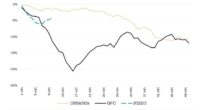
Opinions expressed by Entrepreneur contributors are their own.
A while back, I went through the talent strategies for a dozen companies across numerous sectors and came to a frustrating conclusion: It was hard to tell them apart, fueled as they were by nostrums like “reduce turnover,” “improve engagement” and “increase diversity.”
Increasingly, it’s a challenge to tell the industry or geography of an organization if you read its talent strategy with the company name covered up. Too often, it contains just broad generalizations only loosely connected to leadership, business process or planning — is disjointed from day-to-day decisions about individual people. Sometimes, such a strategy isn’t even written down.
Be forewarned that sameness does not yield greatness. Those prevailing similarities are indicative of a real problem in the HR world: We’ve hit a wall.
Decades of progress pushed the profession into what it is today: a business unit that’s good at reducing risks and keeping talent costs low. But processes perfected through multiple transformation cycles — from specialization and scale of David Ulrich’s “three-legged stool” to digital transformation and moving processes to the cloud — have now become the problem. Too many companies have fallen into the trap of looking at every problem through an HR lens, instead of asking the important question, “Is this an HR problem, or a business problem?”
Today, this department has a golden opportunity to better shape business outcomes. Companies that articulate and execute talent strategy well will have a clear competitive advantage in a fast-evolving economy, where finding and retaining the right people is the challenge.
Here’s how HR can get out of its way and start driving real results.
Related: 5 Ways HR Can Drive Success In Today’s Turbulent Times
Think differently about data
Traditional HR data about headcount, compensation or diversity has never gone far enough. Oriented inwardly, it has served to meet certain needs (including compliance, risk reduction and planning) while offering little practical guidance to the rest of the company. It’s time to change that.
This means tapping into new datasets that reflect modern work. Let’s start with skills data. Businesses should consider not thinking in terms of “roles” and start thinking in terms of skills — getting beyond headcount and understanding the critical knowledge that defines the highest-performing departments, or individual workers. HR can create real value for those outside that department only when people data is layered with business data. The only limit is imagination.
Armed with skills data, businesses can move the needle — can predict an ability to deliver on products, understand where they stack up next to competitors and get ahead of recruiting challenges, instead of just reacting to them. The good news is that there
are contemporary skills-mapping platforms that can provide precisely these insights.
Related: The Benefits and Drawbacks of AI Integration in HR Departments
An eye to the network
There is another and equally critical data set: network. Static org charts rarely provide insights into how knowledge is transferred and how work gets done inside organizations. Far more valuable is an understanding of a peer network: Who is meeting, emailing, Slacking and videoconferencing? This information spotlights the real water carriers inside an organization, and contemporary organizational network analysis platforms are revealing more detail in this area all the time.
Today, people data is typically locked behind HR’s walls, but value only emerges when it’s blended with critical business metrics. Combining network and people data might illustrate, for example, who is over-leveraged with meetings and at greatest risk of burnout. Combining people, network and CRM data can also show sales leaders how staff members really spend their time, and so help find a path to achieving quota.
Related: HR Analytics: How Should Big Data Be Used in the Workplace?
Don’t just react… drive change
Tapping into this new and blended data helps us to connect people practices with the bottom line, but that’s just part of the challenge. We also need to ensure that it’s being used proactively, not reactively. Until now, HR has been largely staring into the past; we’ve been stuck asking people to enter data on how the year went when we could be showing how their year will go — or better yet, how their year could go.
With the right people analytics, applied in the right way, we can peer over the wall and change a company’s trajectory — can spotlight, for instance, not simply a team’s highest performers, but what patterns of behavior they share. Then we can use that information to guide others along a path to high performance. But for that to happen, we have to put new insights into the hands of people managers — the frontline leaders who are best positioned to impact teams.
Do you know who does this well? Finance. Think about how CFOs communicate with their companies. They distribute key financial information like profit and loss statements regularly to the entire organization. That information shapes every decision, at every level. HR data, meanwhile, is locked away in the name of privacy and legal compliance. This overly cautious approach all but ensures being stuck in a reactive mode, with more and more analysts gazing into the rearview.
Related: This Entrepreneur Has Solutions for HR Problems You Didn’t Know You Had
We’ve got a wealth of people data. Put it where it counts — in the hands of those who make daily decisions that shape people’s experiences at work, and in turn, directly affect the bottom line. Otherwise, what are we even doing?
In this age of scarce and expensive labor, HR has never been more important. There will be winners and losers, and the companies that don’t articulate and execute on talent strategies will almost certainly be left behind. It’s time for this vital department to truly shine, to lead from the other side of the wall.
This article is from Entrepreneur.com









